A Summer In Place: Exploring Boston with the Teacher Institute!
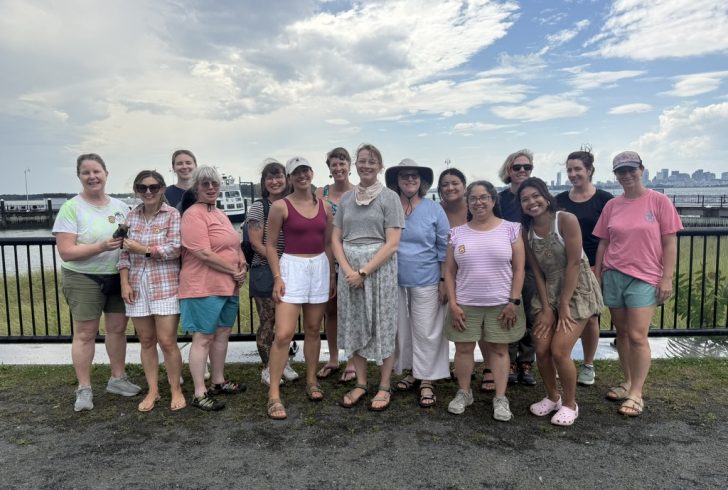

by: Daria Healey
Stone Living Lab Summer Teacher Institute Fellow
Last month, we welcomed thirteen Boston-area teachers and educators for the Stone Living Lab’s fourth annual Summer Teacher Institute! In this free five-day course, we bring teachers, educators, researchers, and other members of the community together to learn about climate change, place-based learning, and participatory science within the local context of Boston Harbor.
This year’s cohort represented schools and education programs in disciplines across the sciences and humanities, serving students from middle school to adulthood. Over the course of the week, the teachers use what they learned in both classroom and field-based experiences to develop a place-based lesson plan, which they can implement in the following school year.
This year’s program was co-facilitated and developed by Daria Healey (Stone Living Lab – SLL), Hannah Heutsche (National Park Service – NPS), Cathy Radonic (NPS), Holly Rosa-Watson (Boston Public Schools – BPS), and Rebecca Shoer (SLL).
Follow along to see the many places and participatory science protocols we explored together!
We kicked off the week at the Commandant’s House in the Charlestown Navy Yard. After initial introductions to the SLL Team, NPS rangers Cathy and Hannah discussed the six core pillars of place-based learning, setting a standard for learning objectives that are: rigorous, real, empowering, collaborative, integrated, and grounded in place. We connected and built upon these pillars throughout the week.
In the afternoon, we were joined by eleven partner organizations for our Protocol Carousel. These Boston-area educators and researchers introduced the teachers to a wide variety of participatory science protocols that their own organizations use and discussed how these protocols could be applied within the teachers’ specific grade levels and topic areas.
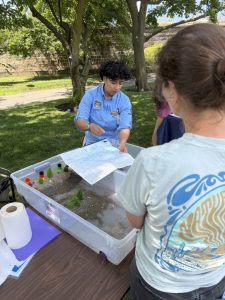
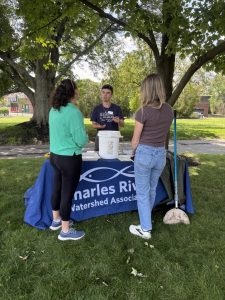
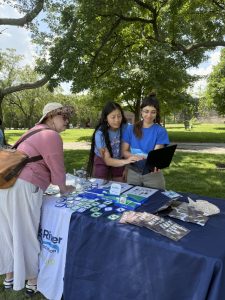
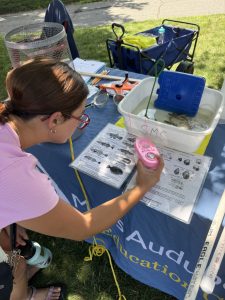
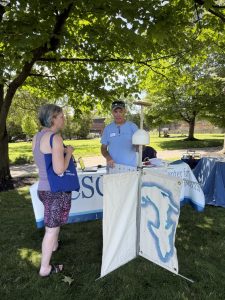
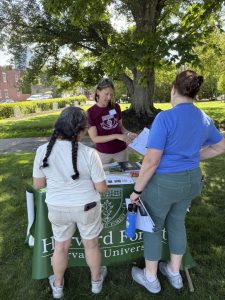
A full list of guest organizations and their participatory science protocols are included below:
Coastal Stewardship Corps member Xiony was also reunited with their high school biology teacher, Sally Rosen!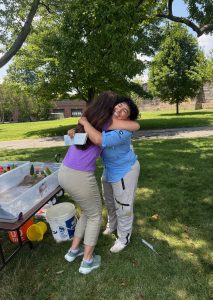
On our second day together, we welcomed three amazing alumni of our Teacher Institute to the Commandant’s House, where they discussed lesson plans that they had implemented in their classrooms using the protocols and principles of the Institute. It was wonderful to see how their projects have grown and changed since their time with us!
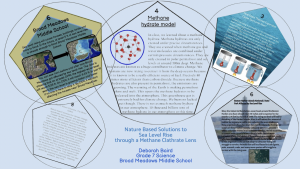
Debbie Baird (2022 Institute cohort) described a project from the previous school year in which students learned about sea level rise and investigated different nature-based approaches for addressing it, culminating in a final artistic presentation of their material in the structure of methane clathrate dodecahedrons.
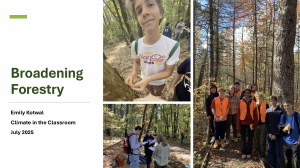
Emily Kotwal’s (2023 Institute cohort) students used protocols developed through two Harvard Forest programs, Our Changing Forest and Buds, Leaves, and Global Warming, to monitor long-term change in a forested region of their school campus. Emily discussed takeaways and lessons learned from the past two years implementing this project, as well as how she hopes to improve and expand the lesson plan for next year.
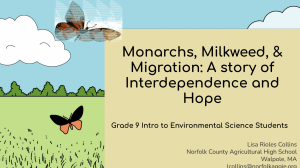
Lisa Rioles Collins (2024 Institute cohort) implemented her Teacher Institute lesson plan for the first time this past school year. Her students used iNaturalist and MonarchWatch to survey plots of land near their school for milkweed and monarch butterflies across all stages of development. In addition to identifying milkweed and monarch butterflies (among other interesting insects that the students found along the way), Lisa’s students collected milkweed seedpods from their campus and dispersed them at a local farm!
In the afternoon, we were joined by additional members of the Stone Living Lab team at the Condor Street Urban Wild in East Boston. After some independent nature journaling and scientific drawing time, Dr. Katie Dafforn (SLL Co-Director) and Liana Greenberg-Nielsen (SLL Education and Engagement Program Coordinator) led us down to the water, where we learned about North America’s first installation of “Living Seawalls” panels.
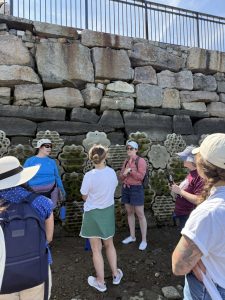
As part of a collaboration between the Stone Living Lab and Living Seawalls, this installation was designed as a pilot for investigating how we can help marine biodiversity thrive in urban coastal environments, with panels that mimic conditions of natural ecosystems.
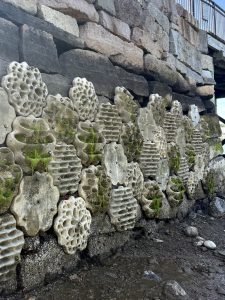
On a beautiful Wednesday morning, we met the teachers for a green infrastructure tour of two local schools in Roxbury. Davis A. Ellis Elementary School and Rafael Hernández Dual Language K-8 School are home to a variety of green infrastructure features. These features are modeled after the characteristics of natural environments to mitigate stormwater runoff, while also providing a variety of additional environmental, social, and economic benefits.
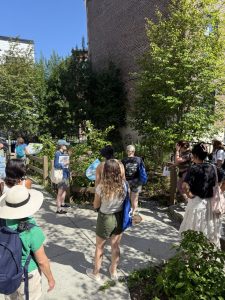
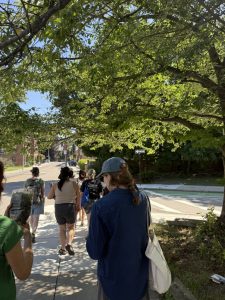
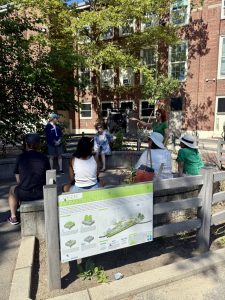
We were joined by Allie Rowe and Rachel Luna from the City of Boston’s Office of Green Infrastructure, Michelle Martinat from Boston Public Schools, and Silvia Castanos from the City of Boston’s Safe Routes to School Program, who led the tour and discussed how students have engaged with their local greenspaces (curricula developed in partnership between Boston Public Schools and the Boston Water and Sewer Commission can also be found here).
Holly Rosa-Watson also joined us in Roxbury – with chalk in hand – to lead the teachers through a fun community asset mapping exercise to close out the tour! 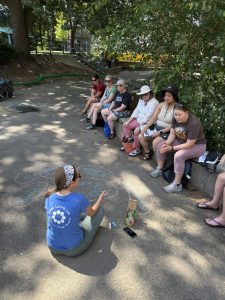
Once back in the Commandant’s House, Holly continued her instruction and introduced the teachers to the three P’s of place-based planning: place, protocol, and partner. This formed the foundation for the afternoon’s activity, where the teachers took their first dive into developing material for their final capstone project and shared their ideas in a “speed dating” activity for additional feedback and revision.
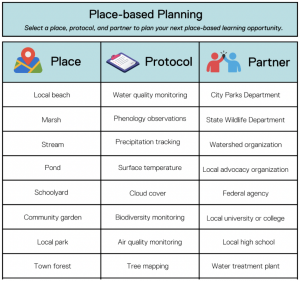 Thursday
ThursdayWith the week of the Institute flying by, we met the teachers on Thursday morning at Carson Beach in South Boston. We explored three participatory science protocols, including beach profiling, marine debris tracking, and a coastal bioblitz. Members of the Coastal Stewardship Corps (CSC), including Xiony Rodriguez, Gabby Levitt, and Tori Young, joined us to share their field expertise and lead the bioblitz using iNaturalist!
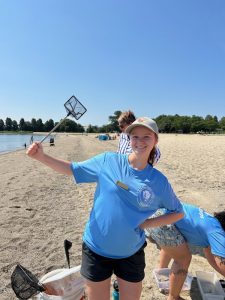
In the afternoon, the teachers put marker to paper to showcase their lesson plans in a Gallery Walk. After presenting their material, the teachers had an opportunity to read through the lesson plans at their own pace and provide written feedback with affirmations, questions, and suggestions. We closed out the day feeling strong about the directions of our projects and ready for our final trip together!
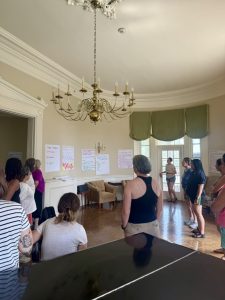
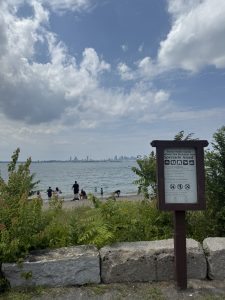 Celebrating the end of the week, we met the teachers at the Leventhal Room in the Boston Harbor Hotel. We eased into the day with a journaling activity, where we listened to a chapter from Dr. Robin Wall Kimmerer’s 2015 bestseller, Braiding Sweetgrass. Then, making our way to Long Wharf, we started our journey to Spectacle Island!
Celebrating the end of the week, we met the teachers at the Leventhal Room in the Boston Harbor Hotel. We eased into the day with a journaling activity, where we listened to a chapter from Dr. Robin Wall Kimmerer’s 2015 bestseller, Braiding Sweetgrass. Then, making our way to Long Wharf, we started our journey to Spectacle Island!
NPS rangers Cathy and Hannah led the teachers on a tour up to the South Drumlin, where they discussed the distinctive history of the island, from glacial formation during the Ice Age to a wide variety of uses and activities from humans across time. Some of these uses had significant harmful environmental impacts, prompting large-scale restoration efforts through the 1990’s. Spectacle re-opened to the public in 2006, offering hiking, swimming, wildlife watching, and coastal relaxation just minutes from the city.
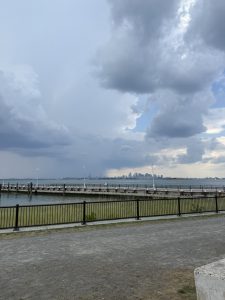
After a beautiful beachside lunch and time for swimming, clouds rolled in across the water. Against the backdrop of summer rain, we closed out our time on the island by swearing in all of our teachers as Junior Park Rangers, complete with badges and their own personal Buddy Bison stuffed animals!
The clouds parted just in time for us to board our boat back to Boston. We are so grateful for the time we got to spend with our teacher cohort this week and for all of the wonderful discussions we shared with teachers and partners from the Boston community! The teachers are now hard at work putting the final touches on their capstone projects and receiving feedback for their presentations later this week, where they will share their lesson plans for the upcoming school year with our collaborators. We look forward to seeing their final products!
